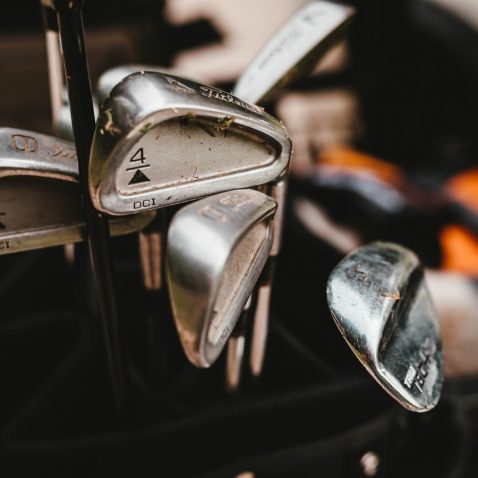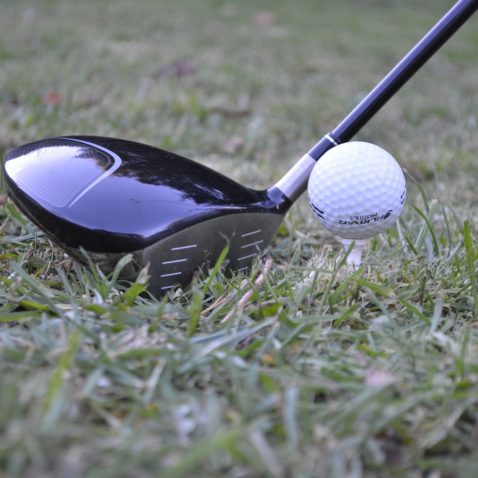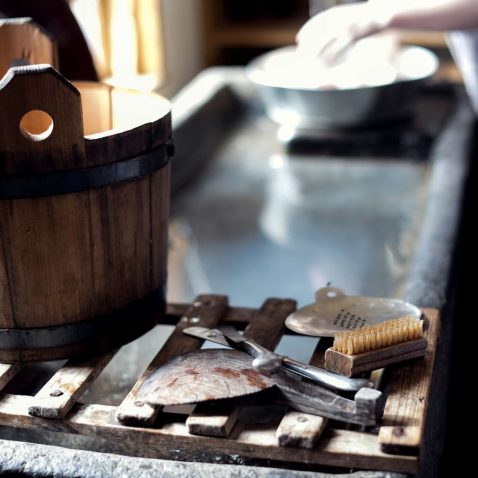How Golf Clubs Work: Numbers Explained
If you’ve played golf before, it may be confusing looking at all the differently shaped clubs and seeing the numbers on them. The numbers aren’t just randomly placed. The numbers refer to the loft – which is the angle of the golf clubface.

Adjusting the loft adjusts the height or distance the ball can travel on impact. The lower the number on the golf club, the lower the loft.
This means the angle on the clubface is less intense, making the golf ball travel further but at a lower height. A higher club number would mean a higher loft.
The angle on the clubface is going to be more intense, making the golf ball travel higher in the air, but for a shorter distance.
So again, low number = low loft and high number = high loft.
Below are the types of club and the average distance for men, to give you some perspective on which club gives you what distance.
- Driver = 23o yards
- 3 wood = 210 yards
- 2 iron = 190 yards (use 4 wood or hybrid)
- 3 iron = 180 yards (use 5 wood or hybrid)
- 4 iron = 170 yards
- 5 iron = 160 yards
- 6 iron = 150 yards
- 7 iron = 140 yards
- 8 iron = 130 yards
- 9 iron = 120 yards
- Pitching wedge = 110 yards
- Sand wedge = 90 yards
- Lob wedge = 65 yards
How Do Golf Clubs Work: What are the Different Types of Golf Club
The typical golfer carries 12 clubs around with them, and each one is specially designed for a specific purpose. In a game of golf, you’re likely to use each one in your set at least once.

Woods
Woods are used for hitting long shots. You’re best using one of these long-range woods to hit off the tee normally the driver or 1wood – as you’re aiming to hit a large distance when teeing off.
If you’re on a longer course, you will probably use a wood for your second swing too, just for that extra distance. The head of the club is hollow-bodied and is larger than other clubs.
You’re probably wondering why they’re called woods when they’re made of metal. Well, they were made of wood before the ’80s. The woods changed from wooden to metal a few decades ago, as metal became more favorable for many reasons.
The main reasons for this being perimeter weighting and low center of gravity, which can only be achieved by the metal being precisely molded. Wooden woods don’t achieve the same standards.
It’s common practice to use your woods when you’re around 175 yards or more away from the green – any closer and it won’t be as effective.
The driver (the 1 wood) has a very low loft. The loft of this is between 7 and 12 degrees, which is great for long-distance, but not that great for getting good height.
Driver clubheads tend to be made of titanium alloys or steel, and the club can be around 45 inches long. The length can make this club especially hard to master in the swing, especially for beginners.
Drivers can be used to hit off the fairway, but even experts can find difficulty in this because of the low loft, meaning the ball won’t gain much height.
Suggested Reading: Best Drivers for Beginners – Our Top Picks for 2020
Most golfers carry 3 and 5 woods in their bag. The 3 and 5 woods are commonly called fairway woods – as they’re often used during the second shot (on the fairway).
A 3 wood has a loft between 15 and 18 degrees, whereas a 5 wood can have between 20 and 22 degrees. As we’ve established, the higher the number, the higher the loft – so you’d use a 3 to go further, and a 5 to go higher.
You can have a 2 wood as part of your set, but they are far less common and aren’t usually included in beginners’ golf club sets. The 2 wood and 4 wood clubs were more popular a couple of decades ago, but the standards of golf clubs have evolved with technology, making the 2 and 4 pretty much redundant.
Irons
You’ll find yourself using an iron when you’re less than 200 yards away from the green. As you get closer to the green, you’ll find yourself using the higher irons.
A typical set of irons will include a 3, 4, 5, 6, 7, 8, irons, and the pitching wedge. They are used on every hole and cover everything from short shots to long-range shots from the tee.
Irons are aesthetically noticeably thinner than woods or hybrids, which can give you an improvement in accuracy. As you get closer to the hole, accuracy becomes more and more important, so it’s necessary to pick the right club for your shot.
The clubheads on irons tend to have deeper grooves which extend across the face from toe to heel. These grooves help you generate spin on the ball.
Only more experienced golfers will be able to use these subtle differences to their advantage, and it does take some practice to be able to use these clubs to your benefit.
Cavity back
If you have a higher handicap or are a new golfer, then you may opt for a cavity back iron. This iron type has a cavity in the back of the clubface, which moves the weight to the perimeter of the club.
The “sweet spot” of irons with a cavity back tends to be larger and allows them to be more forgiving, which is great if you’re a beginner and haven’t perfected your accuracy skills yet.
Steel and Graphite Shafts
A steel shaft is great for strength and stability but tends to be heavier than a graphite shaft. The heavier the shaft, the more work is required to swing. If you’re super strong though, you’ll have no issue using a steel shaft.
If you’re an experienced golfer, you should be able to use this to your advantage. Once you become familiar with the weight and feel, it should be easier to use this to hit the ball in the way you want.
Graphite shaft irons are lighter than steel shafts, so the speed of the swing and therefore the distance tends to be faster and longer. Graphite iron shafts are perfect for beginners, as they require less strength and familiarity to perfect your swing.
Hybrids
Hybrids are becoming increasingly popular. The combination of a fairway wood head design and an iron length shaft is benefitting golfers of all skill levels.
It’s usually the longer irons, such as the 3 and 4 irons that tend to be replaced with the hybrid. This is to increased playability and forgiveness in the more off-center hits.
Hybrid golf clubs are often the best of both worlds and might be something to consider for your next set of clubs.
Wedges
Wedges are really useful, but most golfers only have one or two in their set. They usually increase in around 4 degrees loft.
Gap Wedge
The gap wedge can also be known as the approaching wedge. The gap wedge is better for distance, even though the accuracy is great too.
Sand Wedge
The sand wedge tends to be most commonly used. If you’re unlucky and get your ball stuck in the bunker, the sand wedge is the one you use to get it out.
It is not the most long-distance club but is great for getting the ball off the ground and into the air.
Lob Wedge
If you want to ball to go really high and spin a lot, then you should be using this club. With this club, you have more power to manipulate the ball around the green, so is great if you want the ball to spin to the back of the hole.
Pitching wedge
The pitching wedge is usually found in your set of irons, as it’s sold as part of an iron set, not just on its own.
Putters
The main purpose of the putter is to get the ball into the hole. The design of a putter makes it perfect for short and low-speed strokes, as opposed to long-distance shots.
Every single golf club set will feature a putter. A putter is usually fitted with a steel shaft and includes a grip on the shaft where you can rest your thumb.
The face can vary, but the faces on putters are usually flat or almost flat, and smaller than most other clubfaces.
Blade Putter
This type of putter has a smaller head. This is the most common putter head and it is great if you’re accurate when you’re putting.
Mallet Putter
Mallet putters are becoming a lot more common amongst golf players of all skill levels. Much like a mallet, the mallet putter is top-heavy.
The weight of the clubhead is far from the face, stabilizing the putter head when it hits the ball. This is perfect if you’re looking to straighten your putt.
If you are still unsure about what each club is used for here is a good video that may help you.
How Do Golf Clubs Work: Caring for Your Clubs
Hopefully, by now you understand how golf clubs work so its time to talk about caring for your clubs.
Golf clubs are essential to any golf player, newbie or advanced. They are expensive pieces of equipment and should be maintained well. Keep reading to see the best ways to care for your club, including how to avoid rust, clean rust, and the best way to store your clubs.

Storing Your Clubs
It’s important to make sure you store your clubs in a safe space, where nobody can damage or steal them. Golf clubs can be very valuable, and if you had to replace a whole set, it could set you back a few hundred dollars.
Theft is not the only thing you need to consider when storing your clubs. Hot temperatures, such as in the boot of your car, can weaken the glue that holds the grip and club head in place.
Make sure that you’re not storing your clubs in wet conditions too, as rust can ruin your clubs. Make sure you give them a quick wipe down before storage.
Cleaning Your Clubs
Golf clubs can get quite dirty on the course, especially if you’ve been chipping away at the turf. Make sure you give them a thorough clean before putting them away.
The best way to clean golf clubs is by mixing warm water and mild dish soap and lightly scrub your clubs with a soft bristle brush (maybe a toothbrush) using that formula.
Once it’s clean, make sure you give them a dry using a clean towel before you put it away. You don’t want rusty clubs!
Rust
If it’s too late and you’ve not followed these instructions, do not stress. Rust can be removed from your golf clubs. You’ll need fine steel wool, a hard bristle brush/ toothbrush, wet and dry sandpaper, white vinegar, metal polish, a bucket, and some rags.
Put the white vinegar into your bucket, and wet the steel wool in the vinegar. Rub it against the shaft of the club until the rust starts to disappear. Use the sandpaper and add pressure if it’s still not working.
Give the head a clean next, using the toothbrush and the leftover liquid in the bucket. Once the clubs are clean, use the metal polish and rub it onto the club using the rags.
Golf Towel
If you want your clubs to remain clean and shiny, be sure to make a golf towel part of your golfing equipment. Whenever your clubs get moisture on them, simply wipe it off with your golf towel.
Any towel will do, but you could also purchase a fancier purpose-made golf towel.
Headcovers
Be sure to use headcovers on your woods, as they tend to be more delicate and easily damaged. Even the process of moving the clubs from the course to the car can inflict damage to your club heads, so any extra protection is helpful.
You shouldn’t need headcovers for your irons as they tend to be more sturdy and less breakable.
Grips
The grips should be inspected on a regular basis, for cleanliness, and for wear. Any shiny areas or cracks are signs that you need to replace the grips.
If the grips are damaged, your golf game will be damaged. The grips are important, as you need a firm grip of the club to get the perfect shot.
You can re-grip them yourself if you’re good with DIY, but there are shops that do regripping for you for a small fee.
Summary
Golf clubs come in all shapes and sizes, there are so many different types. A golf club set can vary depending on your handicap and skill level.
If you’re a more experienced golfer, you’ll probably have rarer clubs in your set- clubs that require more skill to use.
After reading this guide you should have an adequate understanding of how golf clubs work, the different types, and purposes, and be able to recognize an iron from a sand wedge.
You will also know how to keep your golf clubs safe and clean, and how to remove rust from the shafts.
Additional Resources
- Best Golf Clubs for Seniors
- Picking the Best Set of Junior Golf Clubs
- The Best Women’s Golf Clubs of 2020
If there’s anything you’d like to add, then drop a comment below. How do you keep your clubs clean? How often do you replace them? Let us know.
Don’t forget to give this guide a share!
Share the Love
If you found this post useful, please let others know about it by sharing it.



